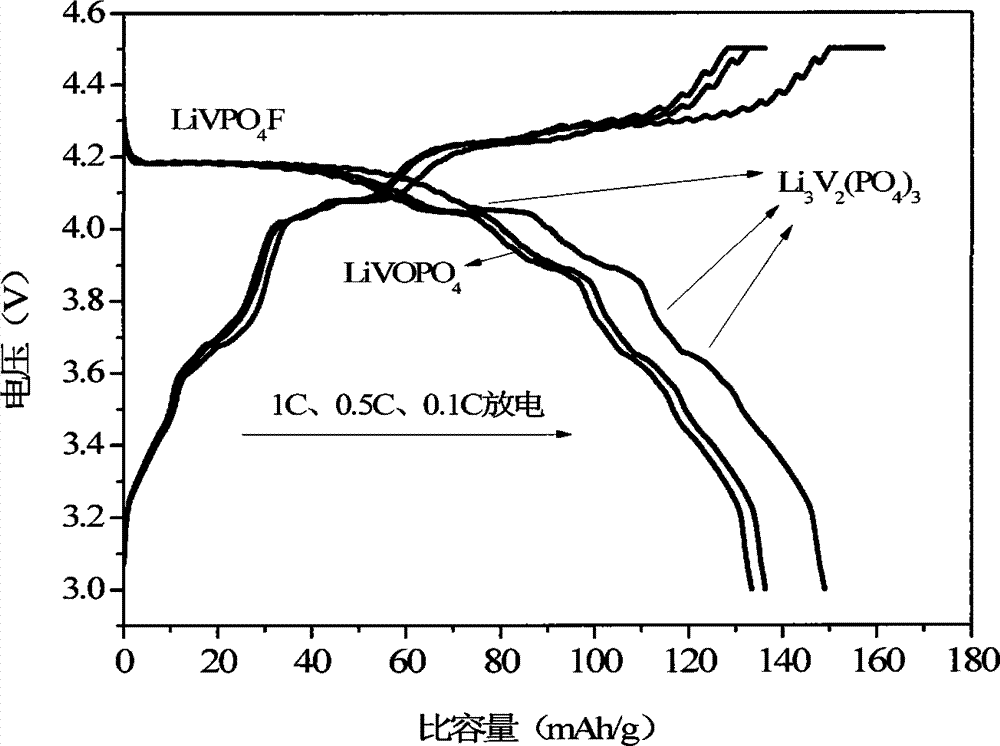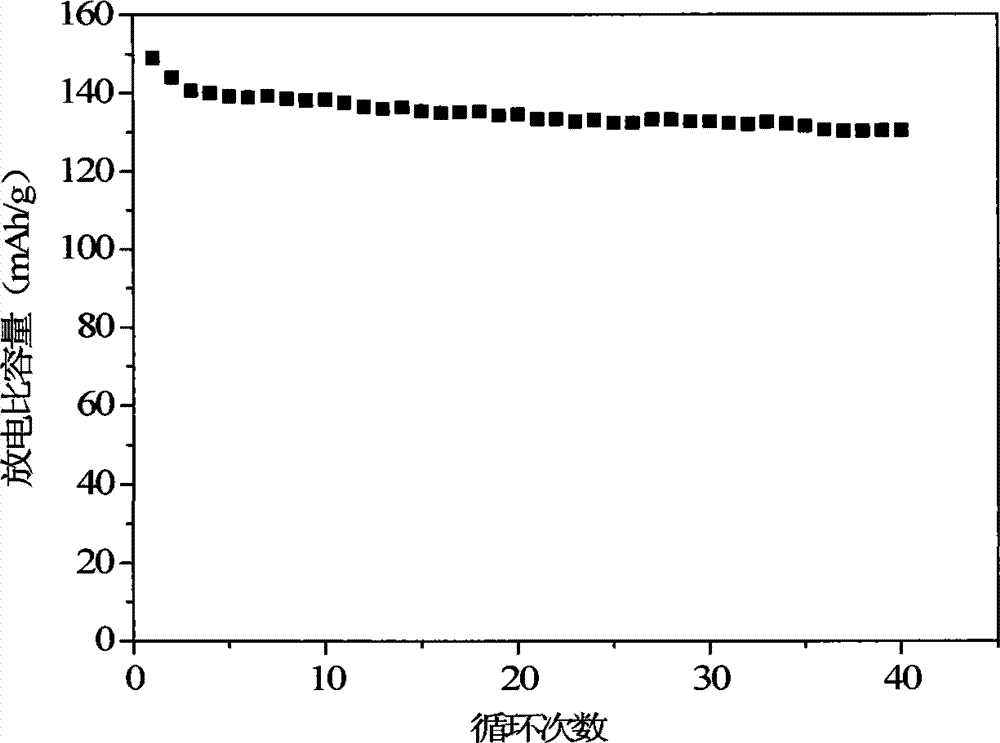Preparation method of multi-core type phosphate compound positive electrode material with core-shell structure for lithium ion battery
A composite positive electrode material and lithium-ion battery technology, applied in battery electrodes, positive electrodes, secondary batteries, etc., can solve the problems of slow ion transmission and low electronic conductivity
- Summary
- Abstract
- Description
- Claims
- Application Information
AI Technical Summary
Problems solved by technology
Method used
Image
Examples
Embodiment 1
[0022] With lithium carbonate, vanadium pentoxide, diammonium hydrogen phosphate, and lithium fluoride as raw materials, LiVPO in the obtained composite positive electrode material 4 F. Li 3 V 2 (PO 4 ) 3 with LiVOPO 4 The molar ratio is 0.1:0.4:0.5, and mix evenly; then add the reducing agent oxalic acid to the mixed material, according to the molar ratio of oxalic acid and vanadium source is 3:1, add and mix, mechanical ball mill for 8 hours, and then turn it to vacuum drying The powder was dried in an oven, fully ground the powder in an agate mortar, pressed into tablets, heat-treated at 750°C for 6 hours in an argon atmosphere, then naturally cooled to 350°C and sintered in an air atmosphere for 1 hour, and finally cooled naturally to room temperature to obtain 0.1 LiVPO 4 F 0.4Li 3 V 2 (PO 4 ) 3 0.5LiVOPO 4 of composite materials. The resulting product was formed into a button battery to measure its charge-discharge specific capacity and cycle performance. The ...
Embodiment 2
[0024] With lithium carbonate, vanadium pentoxide, diammonium hydrogen phosphate, and lithium fluoride as raw materials, LiVPO in the obtained composite positive electrode material 4 F. Li 3 V 2 (PO 4 ) 3 with LiVOPO 4 The molar ratio is 0.2:0.4:0.4, and mix evenly; then add the reducing agent oxalic acid to the mixed material, according to the molar ratio of oxalic acid and vanadium source is 3:1, add and mix, mechanical ball mill for 8 hours, and then turn it to vacuum drying The powder was dried in an oven, fully ground the powder in an agate mortar, pressed into tablets, heat-treated at 750°C for 4 hours in an argon atmosphere, then naturally cooled to 350°C and sintered in an air atmosphere for 2 hours, and finally cooled naturally to room temperature to obtain 0.2 LiVPO 4 F 0.4Li 3 V 2 (PO 4 ) 3 0.4LiVOPO 4 of composite materials. The resulting product was formed into a button battery to measure its charge-discharge specific capacity and cycle performance. The...
Embodiment 3
[0026] With lithium carbonate, vanadium pentoxide, diammonium hydrogen phosphate, and lithium fluoride as raw materials, LiVPO in the obtained composite positive electrode material 4 F. Li 3 V 2 (PO 4 ) 3 with LiVOPO 4 The molar ratio is 0.4:0.4:0.2, and mix evenly; then add reducing agent oxalic acid to the mixed material, according to the molar ratio of oxalic acid and vanadium source is 3:1, add and mix, mechanical ball mill for 8 hours, and then turn it to vacuum drying The powder was dried in an oven, fully ground the powder in an agate mortar, pressed into tablets, heat-treated at 750°C for 2 hours in an argon atmosphere, then naturally cooled to 350°C and sintered in an air atmosphere for 4 hours, and finally cooled naturally to room temperature to obtain 0.4 LiVPO 4 F 0.4Li 3 V 2 (PO 4 ) 3 0.2LiVOPO4 of composite materials. The resulting product was formed into a button battery to measure its charge-discharge specific capacity and cycle performance. The first...
PUM
 Login to View More
Login to View More Abstract
Description
Claims
Application Information
 Login to View More
Login to View More - R&D
- Intellectual Property
- Life Sciences
- Materials
- Tech Scout
- Unparalleled Data Quality
- Higher Quality Content
- 60% Fewer Hallucinations
Browse by: Latest US Patents, China's latest patents, Technical Efficacy Thesaurus, Application Domain, Technology Topic, Popular Technical Reports.
© 2025 PatSnap. All rights reserved.Legal|Privacy policy|Modern Slavery Act Transparency Statement|Sitemap|About US| Contact US: help@patsnap.com



